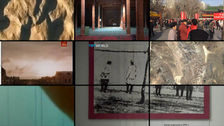中亚日记 | Central Asia Journal | 2018-2021
The Central Asian Journal consists of four relatively independent but possibly related videos and a case report. The four sections consist of "Phase 0", "Phase 1", "Phase 2" and "Phase 3" & "Case Report".
Interpretation 1.
Whether We see “Central Asia” as an idea or a geographical term? A base that is always in the name of migration or the end of multiple expanding ideologies? What language can be used to describe it? The project is based on my personal experience, using "Central Asia" as a backdrop, tracing the photography, images and sounds of Central Asia from the 19th century to the present day through an informal lens, comparing and contrasting the existing fragments of geography, history and memory, and discussing those "knowledge" and visual materials in a daily narrative form and the possible traces of power, identity and cognitive contradictions behind those visual materials. I depict the different shapes of 'Central Asia' while comparing and referencing these shapes to imagine the past and present of 'Central Asia’.
Interpretation 2.
"Abliz" and its related "reality" seems to be the illusion that "Artist" gradually came up after researching history, collecting materials and field study. In brief, “Artist” could be Marx in "Mary and Marx", Russell Crowe in "Beautiful Mind", Leonardo DiCaprio in "Shutter Island" or even Danny Torrance in "The Shining". It took "Artist" a long time to realise this.
In addition to the above, “Palov-osh vol.6-Central Asia Journal” is a supplementary reading to the Central Asian Journal project (2018-2021), which begins at both ends and ends in the middle. Readers can use it as an annotation and expansion of the project, or as a journal and scrapbook for the artist. Although there is no table of contents or index, the structure of book <Central Asia Journal> essentially parallels the narrative flow of the images in the project, using the artist's experience as a point of origin to trace the unique history and associated heritage of 'Central Asia' and related regions. The images involved in the project become a fractured and open narrative in the form of an 'atlas' of sorts in the readings: the material is drawn from a variety of sources collected by the artist in the course of his fieldwork and studies, such as news reports, book illustrations, maps, everyday photography, etc., which are interwoven with each other, sometimes closely related, sometimes relatively loosely.
Phase 0:刀 / Pichak
2021,单频录像,彩色,有声,22’26’’
影像截图 Video Still

Phase 0:刀 / Pichak ,Music Part
Phase I:纯粹的中亚阐释 / The Interpretation of pure Central Asia
2017 - 2021,单频录像,彩色,有声,22’46’’
影像截图 Video Still

Phase II:阿不力孜如是说/ Thus Spoke Abliz
2018 - 2021,单频录像,彩色,有声,10 ’10’’
影像截图 Video Still

Phase III:我的好友 / My Friend
2018 - 2021,单频录像,彩色,有声,14’20’’
影像截图 Video Still

A Case Report——The “Artist” in the Context of Schizophrenia
ENG
3201 words
CN
5248 words
项目读物:《抓饭Vol.6-中亚日记》
Project printed material:“Palov-osh vol.6-Central Asia Journal”
B5,164p,全彩印刷























































